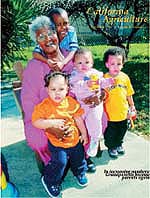All Issues
Letters: April-June 2005
Publication Information
California Agriculture 59(2):52-52.
Published April 01, 2005
PDF | Citation | Permissions
Full text
La Conchita and mudslide science
In the horrific mudslide in La Conchita, the news media were focused on the tragedy and neglected to address the science. The most valuable footage was taken by a helicopter, which showed the elevation of the slide area and the fact that it was gently sloping, heavily planted land. Apparently it got saturated from the rains by holding the water in the soil. There are untold thousands who want to live in the scenic hills; those homeowners need to know the science of mudslides. Are the hills trapping all the water and does little run off? Why was the root system of trees not able to cope or was that brush and no significant tree cover? Was the original tree cover destroyed in periodic fires, making the hills dangerous? With all these rains, it will be important to monitor how many slides occur and where.
WHAT DO YOU THINK?
The editorial staff of California Agriculture welcomes your letters, comments and suggestions. Please write to us at calag@ucop.edu or 1111 Franklin St., 6th fl., Oakland, CA 94607. Include your full name and address. Letters may be edited for space and clarity.
Nicholas Sitar, UC Berkeley professor of civil engineering, responds:
The short answer is that there is a lot of research on the subject and we know a lot. Usually the biggest problem is not a lack of scientific knowledge but the fact that public policy does not have a good way of dealing with geologic uncertainty. In addition, generally there is no money to deal with these problems proactively, unless something terrible happens.
Specifically, regarding the possibility of debris flows (or mudflows), the fact is that they occur in all climatic zones. The principal difference is the threshold amount of precipitation and its intensity. Desert areas of California, Nevada, Utah and Arizona are well known for their destructive flows. Unfortunately, the rapid urbanization of previously untamed land has often not kept pace with the proper mitigation of these hazards, and the occurrences of destructive debris flows are increasing (they were there all along, but there were no houses in their path).
On Jan. 10, 2005, a landslide struck the community of La Conchita in Ventura County, destroying or seriously damaging 36 houses and killing 10 people.
Vegetation does play a role in certain climates. For example, debris flows are rare on heavily forested slopes, but become more frequent with deforestation. Fire has been similarly implicated in increased landslide susceptibility in areas where it eliminated deep-rooted vegetation. In sparsely vegetated desert areas, debris flows are more common and often are the principal mode of erosion and sediment transport. In desert settings, the source areas and the depositionalfans are relatively easy to map, and hazard maps have been prepared for many locations. The problem is in translating these maps into concrete public policy.
For more information, go to the USGS Landslide Web page: http://landslides.usgs.gov/ . In addition, see the National Research Council report, “Partnerships for Reducing Landslide Risk: Assessment of the National Landslide Hazards Mitigation Strategy” (2004): www.nap.edu/openbook/0309091403/html/51.html .
Nicholas Terebey, Jr.
Laveen, AZ
Grandparenting articles still inspire
I happened to access several articles about grandparents raising grandchildren on your Web site (March-April 2001). I found this such interesting reading, since I raised a grandchild in California. She is now 23. I had a lot of hard roads to cover, but did so with a supportive family.
I am a Senior Assembly Member on the California Senior Legislature, and as such we prepare yearly proposals to present to the state legislators in hopes they will be picked up and written into law. I would like to work this year on a proposal to present at our session next October relating to desired legislation regarding grandparenting laws.
Is there a Web site I can access, or literature that will allow me to familiarize myself with California laws covering this issue, as well as possible problems and concerns I could address in potential legislation at state level? I feel a strong desire to assist at both ends — the young and the old — because I see a need. We all have to deal with abuse, fraud, neglect and caregiving concerns.
Sally Wieck, Senior Assembly Member
California Senior Legislature
Baldwin Park
Thank you for your continued interest in this important subject. A good Web site to start with is: www.aarp.org/life/grandparents/helpraising .






